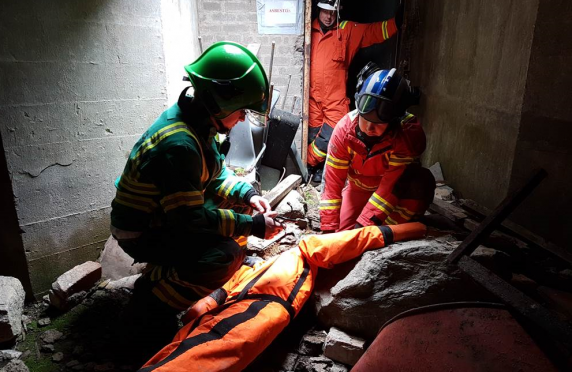A major rescue operation was launched after a building collapsed in the north-east – as part of a training exercise for the emergency services.
Firefighters and paramedics took part in the operation at Portlethen, where they were faced with the challenge of crawling through rubble to reach “casualties” after the building collapsed.
The exercise was designed to train up members of the fire service, who are part of the UK International Search and Rescue unit that responds to natural disasters around the world.
The Scottish Fire and Rescue Service is one of 27 expert teams available to respond after earthquakes, hurricanes, tornadoes and tsunamis.
During the training exercise at SFRS College Portlethen, the teams used their specialist skills to find, stabilise and bring the casualties safely from the ruins.
Crew manager Martin Vardy, who previously travelled to Nepal after the earthquake last year, said the training was invaluable.
“This exercise focused on casualty care, which is obviously a key part of disaster operations,” he said.
“It was great to have the help of the ambulance team as we practiced stabilising severely injured people and getting them safely from collapsed structures.
“Firefighters and paramedics work side-by-side at incidents every day so there’s obviously a huge amount of respect between our two services.
“Taking part in a joint exercise with their special operations response team was a great opportunity to benefit from their medical expertise and that’s something that can only benefit us and the people we may be sent to help.”
Mr Vardy and his colleagues were sent to Nepal after the devastating earthquake, which killed nearly 9,000 people and left 23,500 injured.
They played a key role in the stricken areas, which had been cut-off from the rest of the country and left unable to access even basic medical help.
Dropped into position by helicopter, the firefighters helped shore-up a brick column threatening a hospital and provided the building with clean water, which meant 800 beds and 10 operating theatres could be put back into use.
Their training also equipped them with the skills to set a young boy’s broken arm using a plastic bottle as a splint, and to provide first aid to countless residents of isolated villages.
Mr Vardy added: “As well as our regular duties with crews at our stations we also train as a team every month.
“It’s important to maintain these skills so we’re ready if we are needed.”
